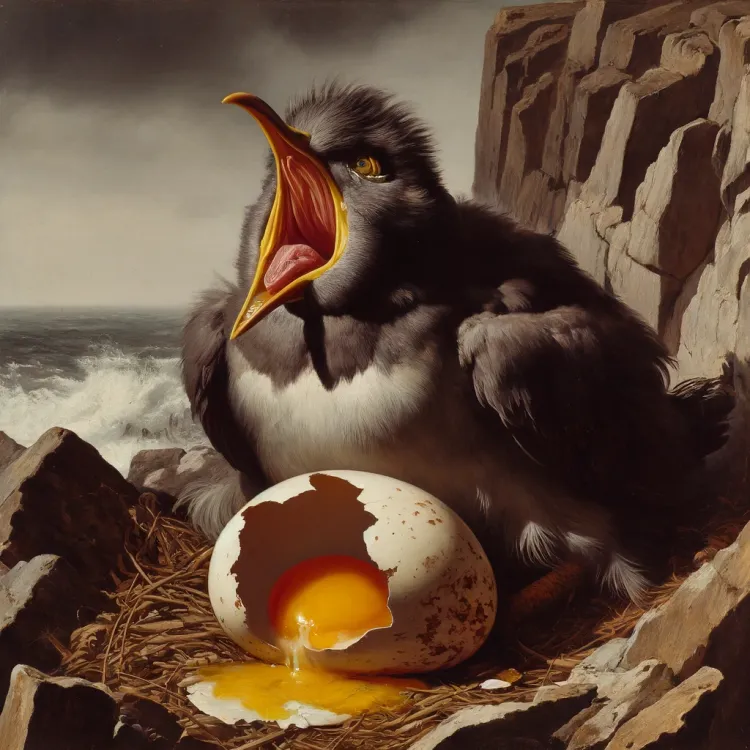The Falcon

Right before I graduated college, I secured a position as a field assistant in Perú. One of my last school projects was on the avifauna, or bird life, of the Amazon. That's where I was going, and I didn't know my arse from a motmot. Or a tanager, woodcreeper, manakin, bushtit, screaming piha, or royal flycatcher, for that matter.
I got a decent grade on the report, but I'm not sure I learned much. I couldn't have told you much about the embodied experience of the hundreds of different species of hummingbirds that live in the Amazon, for example. What does a motmot look like? What does the scream of a screaming piha sound like?
I had no idea, but I dutifully copied someone else's dusty words from the library into my own , thinking that's how the system worked.

There wasn't much on forest falcons, the species I was going to study. My scientific mentor was one of the first to trap and research these rare birds in their home, deep in the jungle.
So my report was pretty sparse on the genus Micrastur, although I did mention them. And very likely with an air of self-satisfied mystery. I'm going to the jungle, boi!
One creature I knew nothing about, that is until I was deep into the forest, was Chullachaqui.1

Legend has it that Chullachaqui is a forest spirit, sort of human, and sort of animal. Sort of like an Amazonian Sasquatch. Of course I was interested.
According to the locals, he'd only appear if you were alone, and deep in the woods. He takes the guise of a friend–you really can't tell him apart from any of your other friends, so the story goes. He'll lure you deeper and deeper into the jungle, until you disappear forever.
The only way to save yourself is to remember something about Chullachaqui: he has the feet of an animal. If any part of your brain seems skeptical about your bestie amigo drawing you away from safety, just check his footwear. Apparently, his feet can take the form of any animal: falcon, monkey, tapir, jaguar, you name it. How the feet would be portrayed in the form of a snake or a millipede (or a clam, for that matter), were never fully explained to me.
Anyway, they could have been messing with me. They only told me about Chullachaqui on a dark night, while sleeping on moldy pads a couple of miles from the research station on an all night tapir "hunt".2
Whether or not this counts as jungle hazing or not, I reserve judgement. I did, however, figure out a couple of things in my time there. Including how to trap local birds. We'd set up fine mesh nets and trick them with prerecorded calls. The goal was to piss off forest falcons, and lure them into a "fight", which would have them hit the net and get tangled. Where we could untangle them, collect our data, and be on with our days.
Of course, forest falcons are pretty rare. And the call of a predatory raptor has a way of stimulating the literal "flight" response in all sorts of local avifauna. So we got a lot of by-catch.
But I finally found out what a woodcreeper is.

Those suckers bite hard for being all of 50 grams.
I get it–I'd be ticked off if I was in the clutches of some devious primate, poking and prodding me before snapping a cheap, pixelated photo on his 2005-era digital camera.
But we took good care of our accidental victims, and I learned a great deal about birds: how to handle them, how aggressive some of them are, how they sort themselves into different aerial strata. I also found out how delicate they are, when my mentor and I desperately struggled to nurse a stunned hummingbird back to health during an intense thunderstorm, far away from the research station.
However, I had spent months in the forest, conducting dawn, dusk, and nighttime surveys. And I still hadn't seen a forest falcon. I'd heard them, in the magical time around sunset when thousands of orange, bioluminescent beetles (Pyrophorus spp.) drift languorously under the canopy, like they're riding a wave of invisible ether.

I figured Chullachaqui saw all this.
But I never had an encounter. I made sure to check people's feet every time I'd meet them out in the trail system. I was a lot more confident on my own in the jungle, but you never know, you know?!
When you're by yourself, it's not always the most reassuring thing to know that those fresh jaguar tracks crossing the muddy trail might be from an actual Jaguar.

Maybe he knew I was trying to help? I certainly tried to approach the place with respect and humility– two things that were in very short supply in my 22-year-old self!
I never saw a jaguar while I was there, but the jungle did start to creep in. I began to have dreams about the place, lost in visions where I would take the form of an animal. It was likely a mild case of malaria or some other disease completely foreign to my immune system.
Day by day, I'd experience something new about the forest: happening upon a large tapir at night, surprising a herd of collared peccaries, nearly stepping on one of the most venomous snakes in the world, getting into an arguing match with a capuchin monkey over the location of my preferred netting site. (like I said, humility wasn't exactly natural at that age).
Then, one day, we caught a forest falcon.
For real, we checked our mist net for the fifth time that morning, and started hooting and hollering when we discovered what had landed in our trap.

If a woodcreeper's irritated stare can make one feel guilty, a falcon has the brutal, searching power to shake the foundations of one's soul with a gaze of contempt. It's the supraorbital ridges, that all daytime-hunting raptors share, that gives them their RRF (Resting Raptor Face).
Besides the look of hatred on the falcon's face, I remember its absolute fragility. It was so light, but so powerful. It struggled in our grasp, its talons helplessly secured by more experienced hands than my own. We performed the risky task of drawing a blood sample, something that always carries the chance of life-threatening hemorrhage in bird species.3
After a few minutes of what can only be described as scientific molestation, we returned the precious bird back into its home.
We tracked him over the next few months with the tiny radio transmitter we'd attached to his back. Chullachaqui didn't seem to mind. He left us alone on our way back to camp, apparently satisfied with our reasonable incursion into the Amazon. Our deception and intervention had (we hoped) a noble purpose, even without avian consent.

Once you make it back to civilization, in whatever form, you don't have to worry about Chullachaqui any more. He doesn't come into human settlements. Pass the threshold, and you don't need to awkwardly check your friend's feet.
I spent months in the Amazon jungle, and many hours out alone in the forest. We caught falcons three times while I was there, and one of them was the same bird! That's okay, it's still data, and that's what I was there for. I had done my part to bring knowledge out of darkness and into the world, where it could spread to countless dusty libraries for the next generation of lazy college students preparing for field assistant-ships.
And by all of that, I mean I didn't do any of the hard work of science. My mentor did all of that, I was just her dumb birdhand. But I'd like to think that the ideas and humility (I swear I picked up some!) from the Amazon have stayed with me.
Especially as an animal doctor, I find that I often need trickery and deception for my patients. I try to do right by them, but it can sometimes be difficult to know what that is. Often, I need to lure them into a trap, like we did with that forest falcon, so that I can try to help.
Maybe that's why Chullachaqui never bothered us. He's part human and part animal, after all. He gets our psychology, our fractured yet dependent relationship with nature. He knows that some of us have to return to civilization, that some of us are working for a harmonious planet.
Maybe we have his blessing. After all, he can't protect the forest alone.

Consider a donation to the Amazon Conservation Association.
- Although originating in a Spanish-speaking country and foreboding a mythical and semi-sinister presence, he's not to be confused with the chupacabra, Baja California's notorious goatsucking alien.
- Story for another time, but I had some very close encounters with several of the Amazon's most poisonous denizens. All in complete darkness, off trail, and with the distinct disadvantage of being 6'3" and not growing up in the dense jungle.
- Depending on which vein is chosen, there's a risk of an incomplete clot forming and leaking into an air sac. These thin membranes extend nearly throughout the entire bird's body, and are connected to their respiratory system. Puncture one, or leak blood into it, and the animal dies of asphyxiation.





Comments ()